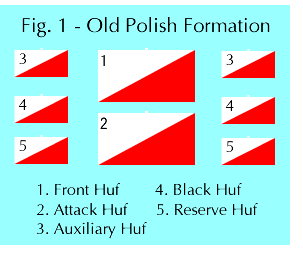|

Second Half of 15th Century
First
Half of 16th Century
Second
Half of 16th Century
First
Half of 17th Century
Reforms
of 1632-1633
Second
Half of 17th Century
The
end of 17th Century
|
 |
Introduction
Since the 13th Century, Poland's
most persistent and consistent foes were the Teutonic Knights in
the North and the Mongol Horde, later the Tatars, in the Southeast.
The contrast between the two types of enemies produced a dilemma
for the Polish army, since a force suitable to combat one enemy
was inadequate against the other. Infantry and artillery, needed
to evict the technologically advanced Teutonic Knights from Prussian
castles, could hardly be used against the elusive Tatar cavalry
in the wide-open plains of the Ukraine. Conversely, the cavalry
required to catch the Tatars was quite useless in a siege. Naturally,
the Poles developed both types of arm, but because of the greater
vulnerability of the open Eastern borders and the decline of the
power of the Knights at the beginning of this period, the Poles
cavalry arm tended to be emphasised and the infantry were usually
restricted to sieges.
Second half of the 15th Century
 At the beginning of this period the Polish army was one with a very
successful recent past (e.g. Grunwald, 1410; Swieta pod Wilkomierz,
1435). It was still a medieval, feudal army based around the heavily
armoured knight, although using some techniques learnt from the splendid
Mongol army. However, this glorious era ended with the knights taking
on political aspirations. In the Thirteen Years War, instead of fighting
the enemy the knights first argued amongst themselves and then, before
they would do battle, demanded certain rights from the King. Worse
still, although the King was forced to accept their demands, the army
was unable to regain its lost discipline and was defeated at the hands
of a small Teutonic force (Chojnice, 1454). The Poles finally defeated
the Teutonic Knights in 1466, but with a mercenary not a feudal, force.
At the beginning of this period the Polish army was one with a very
successful recent past (e.g. Grunwald, 1410; Swieta pod Wilkomierz,
1435). It was still a medieval, feudal army based around the heavily
armoured knight, although using some techniques learnt from the splendid
Mongol army. However, this glorious era ended with the knights taking
on political aspirations. In the Thirteen Years War, instead of fighting
the enemy the knights first argued amongst themselves and then, before
they would do battle, demanded certain rights from the King. Worse
still, although the King was forced to accept their demands, the army
was unable to regain its lost discipline and was defeated at the hands
of a small Teutonic force (Chojnice, 1454). The Poles finally defeated
the Teutonic Knights in 1466, but with a mercenary not a feudal, force.
During the second half of the 15th Century
the feudal basis of the army remained and various attempts at reform
were made. Knights were required to serve, and depending on wealth
would also bring number of retainers. The knight and any retainers
were to be equipped and armed as one of the following cavalry types:
- Fully armoured knight
- Lancer in half armour
- Crossbow man in cuirass
- Swordsman, with helmet & shield
From 1458 towns were required to provide infantry
and artillery a well as cavalry. In times of greatest danger the
peasants were also called up and served on foot. The maximum numbers
of good cavalry at this time were said to be 50,000 for Poland and
20,000 for Lithuania, although these numbers were never actually
used. In the 1490's a current defence force (obrona potoczna) was
formed and used to defend Red Ruthenia from Tatar raids. It was
around 2,000 strong.
 Since
Medieval times the basic Polish battle formation was the Old Polish
Formation (Stare Urzadzenie Polskie), as used at Grunwald and shown
in Fig. 1. It was used very flexibly, the two centre hufs (regiments)
were composed of heavy cavalry and were well spaced to allow lots
of room to manoeuvre. The wings were generally composed of lighter
troops, with the reserve consisting of the best troops. An important
aspect of this formation was its ability to turn and meet flank
or rear attacks. Since
Medieval times the basic Polish battle formation was the Old Polish
Formation (Stare Urzadzenie Polskie), as used at Grunwald and shown
in Fig. 1. It was used very flexibly, the two centre hufs (regiments)
were composed of heavy cavalry and were well spaced to allow lots
of room to manoeuvre. The wings were generally composed of lighter
troops, with the reserve consisting of the best troops. An important
aspect of this formation was its ability to turn and meet flank
or rear attacks.
By the beginning of the 16th Century the poor
discipline of the feudal forces had led to the army being based
solely on mercenaries although in times of extreme danger a general
call-up of the feudal forces would still occur. The method of raising
the mercenary units (called rota) was by letters of summons, these
were sent to the rota commander and set out the unit's type, size,
equipment and period of employment. The rota commander would then
gather nobles, who would bring with them three or four retainers.
The nobleman and his retainers formed a poczet which was the smallest
unit in the army. It was the nobleman's responsibility to arm, equip,
pay and supply the poczet for which he was reimbursed by the state.
Rota sizes varied a great deal but were usually between 50 and 100
men and they were the largest organisational units in the army.
Hufs were purely tactical units used on the battlefield. The army
was raised by the Sejm (Polish Parliament) voting increased taxes
on the nobility. The problem was that the Sejm consisted of nobles
and they were very loath to tax themselves, except for very good
reasons.
1 
|
|

Page 1
|

![]()